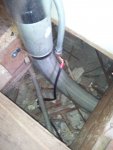sfav8r
Senior Member
- Location
- San Francisco Bay Area
I thought this installation was in compliance because the conduit is bonded to the conductor on both ends. I realize that NORMALLY the conduit would extend all the way to the rod, but it was just easier in this case not to do that. The conduit was only used to protect the 1/0 where it came up through the floor about 18" into the panel (even though the code doesn't require the protection). Since it is bonded on both ends, I don't see why it failed the inspection. The inspector (I was not present) said that the conduit "must continue to and be bonded directly to the ground rod." I don't know what code section he may be referring to. I would like to reread the section if someone has a reference.
Thanks
Thanks


